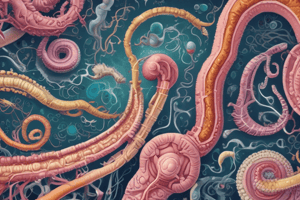Podcast
Questions and Answers
What is the most common route of infection for human sparganosis?
What is the most common route of infection for human sparganosis?
- Consumption of raw or undercooked fish
- Inhalation of contaminated dust particles
- Direct contact with infected amphibians
- Consumption of water contaminated with cyclops copepods (correct)
Which tapeworm larvae can cause human sparganosis?
Which tapeworm larvae can cause human sparganosis?
- Plerocercoid larvae of Taenia solium
- Plerocercoid larvae of diphyllobothriid tapeworms (correct)
- Procercoids of Echinococcus granulosus
- Procercoids of Diphyllobothrium latum
Which tapeworm species' larvae are found inside Cyclops in stagnant ponds and lakes?
Which tapeworm species' larvae are found inside Cyclops in stagnant ponds and lakes?
- Taenia solium
- Echinococcus granulosus
- Diphyllobothrium latum (correct)
- Hymenolepis nana
Which tapeworm larvae can be found in fish, amphibians, and reptiles as plerocercoids?
Which tapeworm larvae can be found in fish, amphibians, and reptiles as plerocercoids?
What is the most common cause of infection for campers and backpackers with tapeworm larvae?
What is the most common cause of infection for campers and backpackers with tapeworm larvae?
Human sparganosis is caused by plerocercoid larvae of diphyllobothriid tapeworms of the genus Spirometra.
Human sparganosis is caused by plerocercoid larvae of diphyllobothriid tapeworms of the genus Spirometra.
The larvae of H. nana commonly infect humans and are a major cause of tapeworm-related illnesses.
The larvae of H. nana commonly infect humans and are a major cause of tapeworm-related illnesses.
The life cycle of Spirometra matches that of Diphyllobothrium latum.
The life cycle of Spirometra matches that of Diphyllobothrium latum.
The infective stages of tapeworm larvae can only be found as plerocercoids in fish, amphibians, and reptiles.
The infective stages of tapeworm larvae can only be found as plerocercoids in fish, amphibians, and reptiles.
Drinking water contaminated with cyclops copepods is the most common route of infection for tapeworm larvae.
Drinking water contaminated with cyclops copepods is the most common route of infection for tapeworm larvae.
Flashcards are hidden until you start studying




